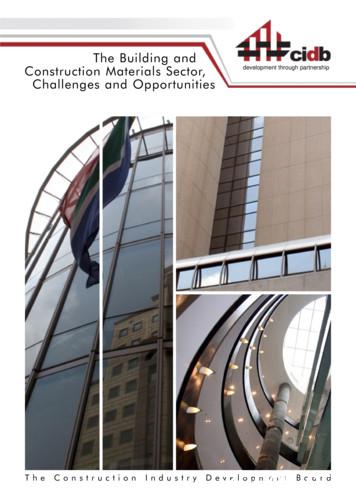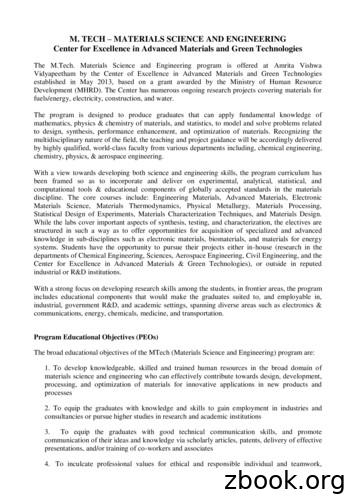MATERIALS OF CONSTRUCTION - AYBU
CE 244MATERIALS OF CONSTRUCTION
Course Objectives To develop a basic understanding of keymaterial properties, requirements, and relatedbehavior characteristics of typical constructionmaterials.
Course Content TypesProduction methodsUses in constructionProperties and related tests of the followingmaterials of construction: Building StonesMetalsClay ProductsGypsumLime CementsMineral AggregatesConcreteTimber
Course Content These materials are used in all civilengineering structures such as; buildings,bridges, highways, railways, tunnels, dams,harbor structures, towers & etc.
CLASSIFICATION OF CIVILENGINEERING MATERIALS1.According to their phases2.According to their internal structure &chemical composition
Phase Classification1. Gases : Air, oxygen, CO22. Liquids : Water, chemical admixtures3. Semi-solids : Fresh pastes, mortars, asphalt4. Solids : Metals, hardened concrete
Internal Structure & ChemicalComposition Classification1. Metals : (formed by metallic bonds)A. Ferrous (iron, cast iron, steel)B. Non-ferrous (aluminum, copper, zinc, lead)2. Polymers : (long chains having moleculesof C, H, O, N which are formed bycovalent bonding. The chains are bound toeachother either by covalent bonds or Vander Waal’s forces.)A. Natural (rubber, asphalt, resins, wood)B. Artificial (plastics)
Internal Structure & ChemicalComposition Classification3. Ceramics : (mainly aluminosilicates formedby mixed bonding, covalent and ionic)A. Structural clay products (bricks, tiles, pipes)B. Porcelains4. Composite Materials :A. Natural (agglemerates)B. Artificial (Portland cement, concrete)
Internal Structure & ChemicalComposition Classification5. Reinforced Composite Materials :(reinforced concrete, reinforced plastics) One of the most important task of anengineer is to select the most suitablematerial for a given civil engineeringstructure.
Factors Determining the Choiceof Proper Material for a Structure Strength, rigidity & Durability Requirements–––– Permanent loading Creep StrengthRepeated loading Fatique StrengthImpact loading Toughness & ResilienceSurface loading Hardness & Resistance to abrasionEnvironmental Requirements– Temperature change coefficient of thermal conductivity– Moisture movement permeability– Chemical effects chemical composition
Factors Determining the Choiceof Proper Material for a Structure Economy. Choose the cheaper & availablematerials considering– Initial cost– Useful life– Frequency of maintenance– Cost of maintenance– Salvage value– Comfortability
Example: Comparison of concretepavement vs. asphalt pavement foreconomy.ConcreteAsphaltInitial Cost– Useful Life –Frequency of Repair –Cost of Repair– Salvage Value Comfortability–
General Properties of CivilEngineering Materials Physical **Mechanical **ChemicalOther– Thermal, Acoustical, Optical, Electrical** Most CE Applications Focus on Physical& Mechanical Properties
Physical Properties Properties of physical structure––––densityspecific gravityporositypermeability– surface energy– texture (micro, macro)– other (color, thermalexpansion, shape)
Mechanical Properties Resistance to applied loads (stress)initially & over time– stiffness– strength– fracture / yielding(brittle / e (bending)torsiondirect shearmultiaxial
Chemical Properties Chemical composition, potentialreaction with environment– oxide content– carbonate content– acidity, alkalinity– resistance to corrosion
Determining the Propertiesof Civil Engineering Materials Properties of materials are determined by Laboratory testing Field testing. To avoid inconsistencies in test resultsSTANDARDS are devised which describethe test apparatus and the procedure.
Items that are usuallystandardized in a test are: Obtaining test specimens and number of specimensSize and shape of the specimenPreparation of specimens for testingTemperature & moisture during preparation &testingType of machineryRate of loadingInterpretation of test resultsWriting a report
Standardization InstitutesTurkey - Turkish Standards Institute (TSE) England - British Standards Institute (BSI) Germany - Deutsche Institute Norm (DIN) U.S. - American Society for Testing andMaterials (ASTM) Europe - European Committee forStandardization (CEN)
CEMENTITIOUS MATERIALS Although there are several differentmaterials which have adhesive properties,three types are of particular interest to civilengineers.Glues : materials of gelatinous naturederived from vegetable or animal sources.Bituminous Materials : complex hydrocarbonVarious Compounds of Calcium : gypsum,lime, cements
CEMENTITIOUS MATERIALS Cementitious materials are substanceswhich, upon certain chemical reactionsattain binding properties Non-hydraulic cements (gypsum and lime) Hydraulic cements (portland cement) Hydraulicity is that property of gainingbinding value when mixed with water andremaining stable when exposed to water.
SPECIAL PROPERTIES OFCEMENTITIOUS MATERIALS Fineness : Particle size.Normal Consistency : A standard amount of waterwhich gives a certain fluidity to the paste.Time of Setting : Beginning of complete loss ofplasticity.Sand Carrying Capacity : Amount of sand that canbe added without harming plasticityHardening : Formation of solid phase; completeloss of plasticity.Yield : Volume of final product obtained incomparison with volumes of constituent materials.
of C, H, O, N which are formed by covalent bonding. The chains are bound to eachother either by covalent bonds or Van der Waal’s forces.) A. Natural (rubber, asphalt, resins, wood) B. Artificial (plastics) 3. Ceramics : (mainly aluminosilicates formed by mixed bonding, covalent and ionic) A. Structural clay products (bricks, tiles, pipes) B. Porcelains 4. Composite Materials : A. Natural .
construction materials sector. A key focus of this study has been on: opportunities and challenges in the building and construction materials sector, and specifically; opportunities for new job creation, enterprise development, and empowerment in the building and construction materials sector.
construction classes, you'll need to be able to answer the following questions: 1. What materials make up the frame? 2. What materials make up the interior and exterior bearing walls? 3. What materials make up the floor construction? 4. What materials make up the roof construction? 5.
construction materials and in the transport of these materials. If the consumption of the construction materials remains the same all around the world then by the year 2050 the production of the cement in the world could reach 3.5 billion metric tons. But annually the production and consumption of the construction materials are increasing
The core courses include: Engineering Materials, Advanced Materials, Electronic Materials Science, Materials Thermodynamics, Physical Metallurgy, Materials Processing, Statistical Design of Experiments, Materials Characterization Techniques, and Materials Design.
The construction industry experiences a larger burden of deaths at road construction sites than any other major industry. From 2011 to 2016, 532 construction workers were killed at road construction sites, more than twice as many fatalities as all other industries combined (chart 3). The number of fatalities among construction workers at
Construction in Malaysia is rapidly increase nowadays especially involving high rise construction. As tower cranes also extensively used for hoisting materials in high rise construction, its operation also increasingly involved in a high rise construction. The usage of tower crane at construction site also created several of risk and hazard that
6. Construction Materials and Appliances If the construction materials to be used for the construction of biodigester are not of good quality, the biodigester will not function properly even if the design is correct and workmanship involved in construction is excellent. The plant will never be of high quality if inferior quality of
4 Palash Hindi Pathya Pustak 8 Rohan 5 Amrit Sanchey (H)(Premchand Stories) Saraswati 6 Main Aur Mera Vyakaran 8 Saraswati 7 Maths 8 NCERT 8 Maths (RS Aggarwal) 8 Bharti Bhawan 9 Science 8 NCERT 10 Science Activities 8 New Age 11 History 8(1) NCERT 12 History 8(2) NCERT 13 Civics 8 NCERT 14 Geography 8 NCERT Oxford School Atlas (B/F) OUP IT Beans 8 (B/F) Kips. 15 Pleasure Rdg : Shakespeare .























